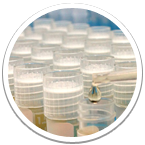Botnia Study
The Botnia Study was established in 1990 in order to investigate and explain connections between diabetes risk factors and environmental factors at three care centers in Osthrobothnia; Närpes, Korsholm and Malax-Korsnäs. At a later state the Study expanded to also cover Jakobstad and Vasa, along with other areas in Finland and southern Sweden. Until today, more than 15 000 people from 1400 families have participated in the project. The Botnia Study is still ongoing and new participants are actively recruited.
The Botnia Study has four aims:
- To identify early disturbances in persons with risk of suffering from type 2 diabetes
- To identify gene defects which cause these interferences and which increase the risk of type 2 diabetes
- To investigate which cause these gene defects has for the development of the disease and the outlet of the disease
- To try to prevent the development of type 2 diabetes
Sample collections of Botnia Study available in THL Biobank
- Botnia Study has investigated since 1990 people with diabetes and their family members in Närpes, Malax-Korsnäs, Korsholm, Vasa and Jakobstad (later also in Helsinki).
- SIB Study investigated in 1994-1997 people with diabetes and their family members in Helsinki, Mikkeli, Lappeenranta, Pori, Rovaniemi, Joensuu and Posio.
- MIX Study investigated in 2002-2013 families where both type 1 and type 2 diabetes occurred.
- PPP Botnia Study has investigated since 2004 people in Ostrobothnia that were randomly selected from the population register.
Samples and data available in THL Biobank
A brief introduction to the Botnia Study and description of the material available in THL Biobank can be found in the 'Read me first' file.
For participants of the Botnia Study DNA samples are available through THL Biobank. In addition for a subset of sample donors also plasma and serum samples are available. For more detailed information, please see the 'THL Biobank Sample availability table'.
Detailed list of attributes available in the biobank can be found in the variable descriptions file.
Genome-wide SNP data is available for a large selection of the study participants, and genome- or exome-wide sequence data is also available for small selection of sample donors. For more detailed information, please see the 'THL Biobank Omics availability table'.
Additional information
Raed more on The Botnia Study website
If you are interested in sample collections focused on study of diabetes see also THL Diabetes Studies and FUSION Study in THL Biobank.
THL Diabetes Studies
FUSION Study
Access to samples and data
Availability queries and application process to access THL Biobank resources
Contact
admin.biobank (at) thl.fi
Collected since 1990, collection is still ongoing
More than 15 000 sample donors (DNA, and serum, plasma and buffy-coat from subsets, aged => 18 y
One of the largest diabetes family collections in the world with extensive phenotype data available
Genome-wide SNP data available




